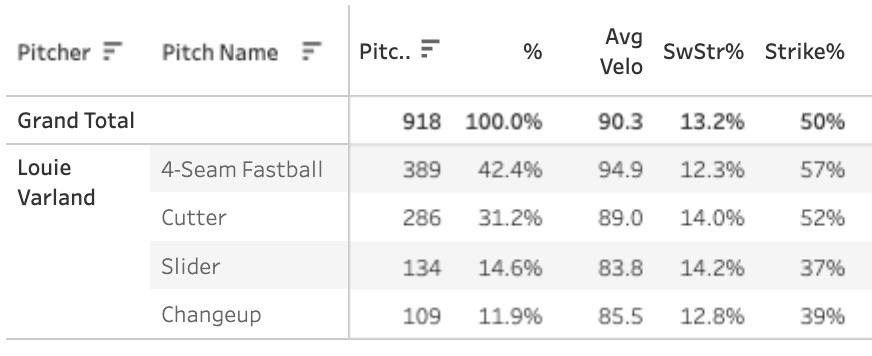Pitch Arsenal Archetyping
An exploration of the league's different, better, and best types of pitch mixes
It’s hard and irresponsible to put players in a box, but that’s what I’m here to do.
I want to try to group pitchers together based on some findings about their pitch arsenal. What made me start thinking about this was finding all of these young pitchers that have a really good slider or changeup, but were without a good enough fastball to back it up. That seems to happen a lot, and it really does hold pitchers back.
So I went further with it and generated a data set that has a summary of each pitcher’s arsenal. Here is what it looks like right now, but there might be more things added by the time I’m done with this. I tend to write these pieces while doing the coding/research, so they evolve (or maybe devolve) as I go.
Arsenal depth = how many pitches he throws >10%
Primary FB = most commonly thrown fastball (four-seamer, sinker, or cutter)
Primary FB Score = Strike% above average for that fastball
Primary Non FB = most commonly thrown non fastball
Primary Non FB Score = Strike% above average for that non-fastball
Duo Score = The scores added together
FB Count = How many of the 3 fastball variations the pitcher throws above 10%
So let’s get into some archetypes. I am being a bit simplistic here in just using Strike%. There are other important things as well, but I didn’t want to get into weighing different metrics together and whatnot, and if I had to just pick one stat for this kind of thing - Strike% made sense.
Lacking a Fastball
The archetype that inspired this post. The guy with the sweet offspeed/breaking pitch that can never really get setup because the fastball doesn’t work.
Gavin Stone is an example. In his short time in the bigs, he posted a sweet 23.5% SwStr% on his slider and a very nice 19.3% mark on his changeup. However, the fastball was awful.
His fastball went for a strike just 40% of the time, a horrible number, and got blasted to the tune of a .407 xwOBA.
Other names in this group
Julio Teheran
Bryce Elder
Drey Jameson
Ken Waldichuk
Daniel Lynch
Edward Cabrera
Brandon Bielak
Lacking a Complement
Louie Varland is a decent representative of this. 73% of his pitches are four-seamers or cutters, but he has nothing else to fall back on with just 25% usage of a bad slider/changeup duo.
He gets a bit of a pass with the cutter there, because that can sort of function like a breaking pitch, but there’s just not wipeout, putaway pitch here (yet). That, plus some other things, got him sent back to the minor leagues, where I’m guessing he’ll be working on that slider.
Other names
Joey Lucchesi
Bryan Woo
Bryce Miller
Alek Manoah
Bobby Miller
Not super surprising to see the Millers and Woo here. These are guys who tore up the minors largely with high-powered fastballs. And in each case, their fastball is working well in the Majors.
Woo throws 77% FF + SI, and the slider at 19% usage has a “fine” but not great 15.8% SwStr% and a 38% Strike%.
As for Bryce Miller, he has taken heavy FF usage to a new level, throwing the four-seamer 67% of the time this year. It has a good 53% Strke% and 12.7% SwStr%, but you can see why he throws it so much - his slider has earned just a 40% Strike%. The curveball has performed pretty well, but he’s only thrown it 6% of the time - so maybe the good performance is just because it’s so unexpected.
And then for Bobby, he has a pitch mix that is five-deep (SI 34%, SL 23%, CH 16%, FF 15%, CU 11%), but all of those pitches are more “good” than “great”. Out of this group, I’d take him - just because of the fact that he has so many different options to improve on. More bullets in the chamber.
The Fastball Variation
The Lance Lynn group! I really like a pitcher that can throw all of a sinker, four-seamer, and cutter at a hitter - that takes them a long way. It’s not to say you can make that your whole living, but it does take a lot of pressure off the slider/curve/change you do have. The full list of pitchers with all three variations working above 10% usage:
Lynn
Syndergaard
Wacha
May
Darvish
E Rodriguez
Rasmussen
Teheran
M Keller
Blackburn
Houck
Martinez
Suarez
S Gray
Strahm
Kelly
Overton
Wesneski
C Anderson
Civale
T Walker
Taillon
Gibson
Rea
Kremer
Wainwright
Davies
If we filter that down to pitchers that also have a non-fastball above the league average by 5%, we get this list:
Wacha
Teheran
Darvish
Martinez
S Gray
Kelly
Overton
Suarez
Blackburn
Houck
Wesneski
Strahm
C Anderson
Yes, that’s Chase Anderson - which casts this group in a not-very-shiny light, he is awful.
What you can tend to get from a pitcher like this is a bunch of called strikes and/or weak contact, like Mitch Keller has shown us this year. This is intuitive, I think, because I would imagine these fastballs are easier to mask/tunnel together as compared to tunneling a four-seamer with a slider or something you have to use a lot different arm action on.
To be frank, I’m speaking out of turn here - I don’t really know much about pitching itself, so correct me if I’m wrong.
The Elite Duo
If we just add together the primary fastball and primary non-fastball scores, we get this top 20. This is effectively a list of the best one-two punches in the league as judged by strike rate.
Springs
Strider
Webb
Lopez
K Crawford
Bello
Ryan
Ohtani
deGrom
Wacha
Glasnow
Snell
Severino
Alcantara
Ober
R Olson
Whitlock
Castillo
Eflin
German
Mostly guys we regard very highly already, but also some more surprising names here like Kutter, Bello, Wacha, and Olson.
So there are four groupings. There are plenty more, and really, pitchers should be looked at individually - but I thought it would be interesting to do this, and to me, it was.
The full data set is available for paid subs below the paywall. Thanks for reading!







